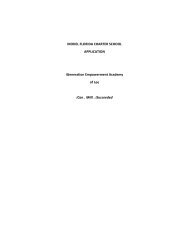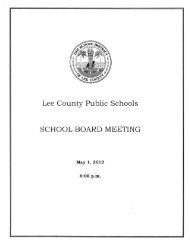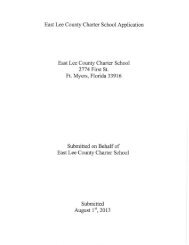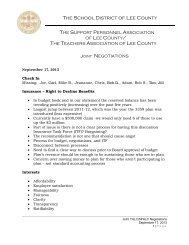Factors Influencing Young Children's use of Motives ... - School Sites
Factors Influencing Young Children's use of Motives ... - School Sites
Factors Influencing Young Children's use of Motives ... - School Sites
Create successful ePaper yourself
Turn your PDF publications into a flip-book with our unique Google optimized e-Paper software.
<strong>Factors</strong> <strong>Influencing</strong> <strong>Young</strong><br />
Children’s <strong>use</strong> <strong>of</strong> <strong>Motives</strong><br />
and Outcomes as Moral<br />
Criteria.<br />
Nelson<br />
(1980)
Morality<br />
• It implies the ability to:<br />
– Distinguish from right and wrong<br />
– Act on distinction<br />
– Experience pride in virtuous act and shame<br />
and guilt over acts that violates one’s moral<br />
standards
Bell Ringer<br />
• When did you start to make moral<br />
judgments ‘good’ & ‘bad’? Age 0-1? 1-4? 5-<br />
7? 8-11?<br />
• Have your views <strong>of</strong> ‘good’ and ‘bad’<br />
changed as you’ve grown older? How?<br />
When? What?<br />
• Where do your views come from?
BACKGROUND<br />
• Jean Piaget<br />
• Morality develops gradually during<br />
childhood<br />
• Under 10 – no consistent evidence for<br />
motive as basis for judgment good/bad,<br />
only outcome<br />
• Above 10 – judgments based on motive<br />
• Stages <strong>of</strong> Development
• Piaget outlined four stages <strong>of</strong> cognitive<br />
development, and gave approximate ages<br />
at which children reached those stages. He<br />
stressed, though, that these ages are only<br />
averages; individual children might go<br />
through the stages at a different speed but<br />
they would always go through the stages in<br />
the same order.
Bell Ringer<br />
• You are each going to receive the same two<br />
moral dilemmas. In your group, you will<br />
have ten minutes on each dilemma to<br />
present your final answer and your groups<br />
reasoning for picking the response you<br />
did. As a class we will do our best to come<br />
to a final conclusion <strong>of</strong> our choice.
Moral Orientation<br />
• heteronomous – ‘subject to another’s<br />
laws/rules’<br />
• autonomous – ‘subject to one’s own<br />
laws/rules’<br />
– Happens at about 7 years old
AIM<br />
• To demonstrate that the children as young<br />
as 3 years old <strong>use</strong> motives and outcomes<br />
as relevant criteria for moral judgments
Hypothesis<br />
• Children as young as 3 years old <strong>use</strong> both<br />
motive and outcome in making moral<br />
judgments if the mode <strong>of</strong> presentation<br />
makes these moral criteria as salient and<br />
keeps them available at the time <strong>of</strong><br />
judgment
Study 1<br />
• Sample:<br />
– 60 pre-school children<br />
– 30 boys and 30 girls<br />
– Age range: 3-4 years old<br />
– Mean age: 3.4 years<br />
– 30 second-grade children<br />
– 15 boys and 15 girls<br />
– Age range: 6-8<br />
– Mean age: 7.4<br />
– From White,<br />
Middle Class,<br />
Urban Area<br />
– Participated with<br />
parental consent
Variables<br />
• INDEPENDENT VARIABLES:<br />
– Motive (Good or Bad)<br />
– Outcome (Good or Bad)<br />
– Type <strong>of</strong> story presentation (Verbal only,<br />
Verbal + implied pictorial, or Verbal + explicit<br />
pictorial)<br />
• DEPENDENT VARIABLES:<br />
– Rating <strong>of</strong> the character
Method<br />
- 4 stories<br />
- In each story, a boy acting with good<br />
or bad motive throws a ball toward a<br />
friend, resulting in a good or bad outcome
Bell Ringer<br />
• Each group will list and explain Piaget’s<br />
stages <strong>of</strong> Moral Development. Do your<br />
best to recall each <strong>of</strong> the stages, the ages<br />
they occur, and a description <strong>of</strong> what is<br />
occurring at each stage. No looking at<br />
notes, so clear your desk! Winning group<br />
gets 110% on the assignment! You have 10<br />
minutes!
Method<br />
1. Children hear story with good<br />
motive and good outcome<br />
2. Children hear story with good motive and<br />
bad outcome<br />
3. Children hear story with bad motive and<br />
bad outcome<br />
4. Children hear story with bad<br />
motive and good outcome
MOTIVE STATEMENTS:<br />
(1) Good Motive:<br />
This boy was playing with a ball; his friend<br />
did not have anything to play with. He<br />
wanted to give the ball to his friend so they<br />
could play catch together with the ball.<br />
(2) Bad Motive:<br />
This boy was playing with a ball; he was<br />
very mad at his friend that day. He wanted<br />
to throw the ball at his friend so he could hit<br />
him on purpose.
OUTCOME STATEMENTS:<br />
(1)Good Outcome:<br />
The boy threw the ball. His friend<br />
caught the ball and was happy to play<br />
with it.<br />
(2) Bad Outcome:<br />
The boy threw the ball. His friend did not<br />
catch the ball; the ball hit his friend on<br />
the head and made him cry.
STORY EXAMPLE:<br />
THIS BOY WAS PLAYING WITH A<br />
BALL; HIS FRIEND DID NOT HAVE<br />
ANYTHING TO PLAY WITH. HE<br />
WANTED TO THROW THE BALL SO HE<br />
AND HIS FRIEND COULD PLAY CATCH<br />
TOGETHER WITH THE BALL. HE<br />
THREW THE BALL. HIS FRIEND DID<br />
NOT CATCH THE BALL; THE BALL HIT<br />
HIS FRIEND ON THE HEAD AND<br />
MADE HIM CRY.
Pictures:<br />
- 2 sets <strong>of</strong> black and white line<br />
drawings<br />
- drawings illustrating the motive<br />
- First set: motives are implied by the<br />
facial expressions. (implied pictorial<br />
presentation)<br />
- Second set: motives are conveyed<br />
explicitly by presenting thought bubbles<br />
(explicit pictorial presentation)
Experimental Design
Procedure<br />
• Children were told to listen very carefully to<br />
the stories beca<strong>use</strong> later they would have to<br />
tell them aloud.<br />
• In both picture-presentation conditions, the<br />
drawings were introduced one by one the<br />
appropriate points <strong>of</strong> the story.<br />
• After each story, children were asked<br />
whether the little boy in the story was a good<br />
boy or a bad boy, or “just okay.”<br />
• Pictures were remained there till the child<br />
made his judgment.
Procedure<br />
• Then they were asked to indicate how good<br />
or how bad the little boy was by pointing to<br />
one <strong>of</strong> the faces on a seven-point rating<br />
scale.<br />
• 1 = very bad, 7 = very good<br />
1 2 3 4 5 6 7<br />
• After the judgment, drawings were removed<br />
• Children were asked to tell the story aloud.
Results<br />
• By condition<br />
– Motive made little difference<br />
– Outcome had a greater effect on moral<br />
judgements in the ‘picture-explicit motive’<br />
condition<br />
– Outcome information was <strong>use</strong>d more (i.e.<br />
made more difference to judgements) in ‘bad<br />
motive’ stories in the two picture conditions<br />
than verbal only
Results<br />
Nelson's results are complex and difficult to understand at times.<br />
Here are a few key overall findings from across both experiments:<br />
• “…making a moral judgment requires understanding <strong>of</strong> the<br />
evaluative concepts (i.e. ‘good’,<br />
‘bad’) to be applied.”<br />
• “Also required is comprehension <strong>of</strong> the motives or goals involved<br />
(e.g. ‘sharing,’ ‘helping,’<br />
‘hurting.’ ”<br />
• ‘bad’ is more important to younger children (it has a greater effect<br />
on ratings) than 'good'<br />
• young children make more recall errors on motives than on<br />
outcomes<br />
• children develop the concept <strong>of</strong> bad before good (initially ‘good’<br />
= no ‘badness’) so <strong>use</strong> the<br />
first negative cue (whether outcome or motive)
Discussion<br />
• It could be possible that children learn the<br />
concept <strong>of</strong> bad before the concept <strong>of</strong> good<br />
(Piaget, 1932)<br />
• It could be possible that young children<br />
define the concept <strong>of</strong> good as the absence<br />
<strong>of</strong> bad, e.g. “being good is not lying” (Hill<br />
& Hill, 1977).
STUDY 2: BACKGROUND<br />
• In study 1, one negative cue (motive) was<br />
sufficient to produce negative judgment.<br />
• 3-yrs olds’ judgment in bad motive<br />
stories were affected by motive but not<br />
by outcome<br />
• Was that beca<strong>use</strong> motive was presented<br />
first?<br />
• Study 2: reverse the order, i.e. present<br />
outcome first then motive
STUDY 2: METHODOLOGY<br />
• Sample:<br />
– 27 preschool boys and girls<br />
– Mean age: 3.8 years<br />
• Material:<br />
– Same as before<br />
– In all stories, outcome preceded motive<br />
• Procedure:<br />
– Same as before
STUDY 2: RESULTS<br />
• As in study 1:<br />
– When one cue is negative, the other cue has<br />
less effect<br />
– Children made more recall errors when cues<br />
were inconsistent (more likely to give benefit<br />
<strong>of</strong> doubt when motive was good)<br />
• As predicted:<br />
– Judgements in Verbal condition were less<br />
affected by motive than picture conditions
Big Issue - Use <strong>of</strong> Children in<br />
Psychological Research<br />
Advantages<br />
• Studying children gives more<br />
<strong>of</strong> an insight into the<br />
nature/nurture debate, as<br />
young children have had<br />
less environmental<br />
exposure (less nurture).<br />
• Children are likely to be less<br />
affected by some biases (such<br />
as social desirability bias).<br />
Their responses may therefore<br />
be more honest and valid.<br />
Disadvantages<br />
• Children are more likely to<br />
respond to researcher’s cues<br />
beca<strong>use</strong> they are more uncertain<br />
<strong>of</strong> themselves. Risk <strong>of</strong> demand<br />
characteristics.<br />
• Clear ethical issues as the child<br />
themselves has not<br />
given consentto take part, and<br />
may not understand that they have<br />
a right to withdraw.<br />
• <strong>Young</strong> children may not<br />
understand or co-operate with the<br />
experiment (e.g. Langlois<br />
removed infants for 'fussing')
Reflective









